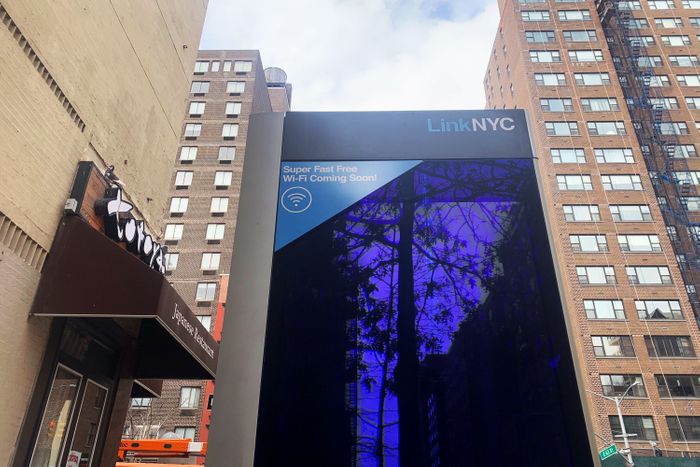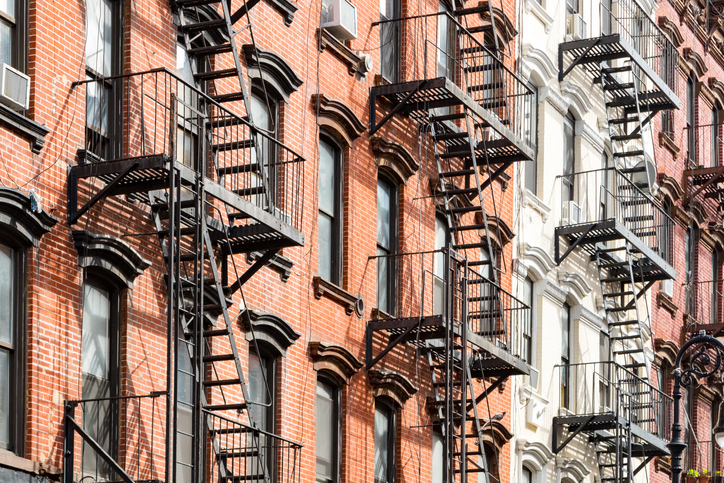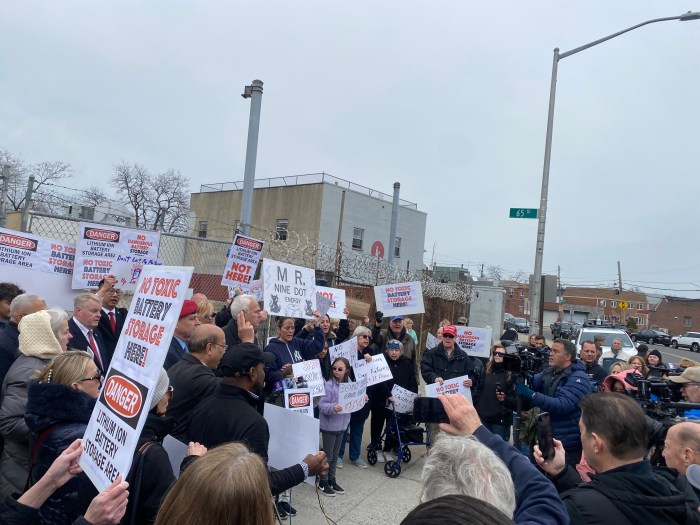By Gabriel Sandoval, Additional Reporting By Ann Choi and Trone Dowd, THE CITY

This story was originally published on Feb. 5, 2020 by THE CITY.
On city sidewalks, sleek LinkNYC kiosks stand idle — installed but not activated.
“Super Fast Free Wi-Fi Coming Soon!” declare signs on their displays.
But when, exactly?
At least 50 kiosks — including one installed as far back as November 2017 — do nothing but occupy space. Meanwhile, more than 1,700 kiosks currently provide passersby with USB outlets, phone access and pixelated advertisements — but there are far fewer of them than promised.
THE CITY visited each unactivated kiosk — all in Manhattan, save for one in Brooklyn — attempting to use their USB outlets, tablet touchscreens, phones, 911 buttons and Wi-Fi. None worked.
“They just come and clean it,” said Orlando Nunez, a doorman at Arthouse Hotel on West 77th Street in Manhattan, where a kiosk has sat unactivated since May 2018.
Jovana Rizzo, a spokesperson for CityBridge, which runs LinkNYC, chalked up the nonworking kiosks to “an ongoing dispute with a service provider.”
“We are working to resolve this issue and activate those Links as soon as possible,” added Rizzo, who declined to give more details, including the service provider’s name.
A Fine Mess
Representatives of the mayor’s office and city Department of Information Technology and Telecommunication, which administers the franchise agreement with LinkNYC, didn’t directly respond to questions about any possible dispute.
But they did say they have fined CityBridge.
“We are disappointed some Links have not been activated or installed, and will continue to use every power we have to ensure the program can deliver results for New Yorkers across the five boroughs,” said Laura Feyer, a spokesperson for the mayor’s office.
“Yes, we have fined them and will continue to use all enforcement tools in our contract if this is not resolved,” added Feyer, who didn’t say how much CityBridge has been fined. “We are extremely concerned that CityBridge has not met its contractually obligated targets, especially in the outer boroughs.”
The franchise agreement directs CityBridge to install 7,500 operational kiosks within a decade.

But CityBridge has fallen behind schedule. The company was supposed to have 2,353 kiosks up and running as of this past July, but fell about 20% short of that benchmark, according to THE CITY’s analysis of DOITT data and the franchise agreement.
Only in Brooklyn has the provider put up more kiosks than promised. As of last year, The Bronx and Staten Island received 60% fewer devices than agreed upon.
The agreement says the city can fine CityBridge $25 per day for the first 30 days that a kiosk “is not timely installed and operational,” then $50 a day for each one after. For not activating the 50 kiosks, per THE CITY’s tally, the city could have fined CityBridge as much as $1.56 million.
‘Pay Phone of the Future’
In the fall of 2014, Mayor Bill de Blasio unveiled the winner of a contest that would replace pay phones with a “first-of-its-kind communications network.”
The winner, CityBridge, promised free Wi-Fi, phone calls and a tablet touchscreen that could connect users to city services, such as the information and complaint hotline 311. The kiosks would be funded by revenue from advertisements, officials said, while bringing in $500 million for the city over the span of the agreement, which was initially 12 years.
CityBridge calls itself a “consortium of leading experts in technology, media, connectivity and user experience.” It includes Qualcomm, a telecommunications equipment company; Intersection, an advertising firm partly funded by Google’s parent company; and CIVIQ, which specializes in “smart cities” planning.
The initial word of a contest piqued the interest of Mark Thomas, a phone enthusiast who’s ran the Payphone Project, a site dedicated to the once-ubiquitous street corner staples, since 1995.
“Anything called the ‘pay phone of the future’ is going to cross my radar,” Thomas said.
Since then, he’s kept an eye on the kiosks, he said. Thomas was perusing the city website, NYC OpenData, one day when he discovered a LinkNYC dataset showing the status of individual kiosks.
“I noticed that some of these inactivated machines have been out there for years,” Thomas said. “I mean, the Montague Street one has been out there over two years, just taking up space.”
He was referring to the unactivated kiosk outside 128 Montague St. in Brooklyn, which was put up on Nov. 9, 2017. It is the city’s oldest installed but unactivated kiosk.

In December, Thomas wrote a post, full of questions for LinkNYC. Among his queries: Why is CityBridge ripping out pay phones and putting up orange pylons in their place?
He called the pylons “obnoxious and maybe dangerous,” and described one on First Avenue in Manhattan that he’s seen lingering for more than a year.
“It’s got nails sticking out of it and it’s rotting,” he said.
The CityBridge spokesperson didn’t comment on why pylons were left on city sidewalks.
“Installations and activations will continue over the next few years,” Rizzo said.
‘One of the Best Things’
While some New Yorkers view the kiosks as an eyesore or worry about their data collection capabilities, others happily use them.
More than 8.4 million unique devices connected to LinkNYC’s Wi-Fi network between 2016 and last year, according to the city Department of Information Technology and Telecommunications. CityBridge says users make an average 200,000 free calls a week.
When Sandra White finished shopping at a Trader Joe’s in Manhattan last week, she only had 3% battery left on her cell phone. So, she walked outside, found a kiosk and plugged in her charger.
“I only use it when my battery’s low,” said White, 55, of Harlem, her phone cord dangling.
She said she had to wait in line because two people were using the plugs before her.
“It’s very handy,” she said of the LinkNYC service. “I think it’s one of the best things the city did.”
This story was originally published by THE CITY, an independent, nonprofit news organization dedicated to hard-hitting reporting that serves the people of New York.


































